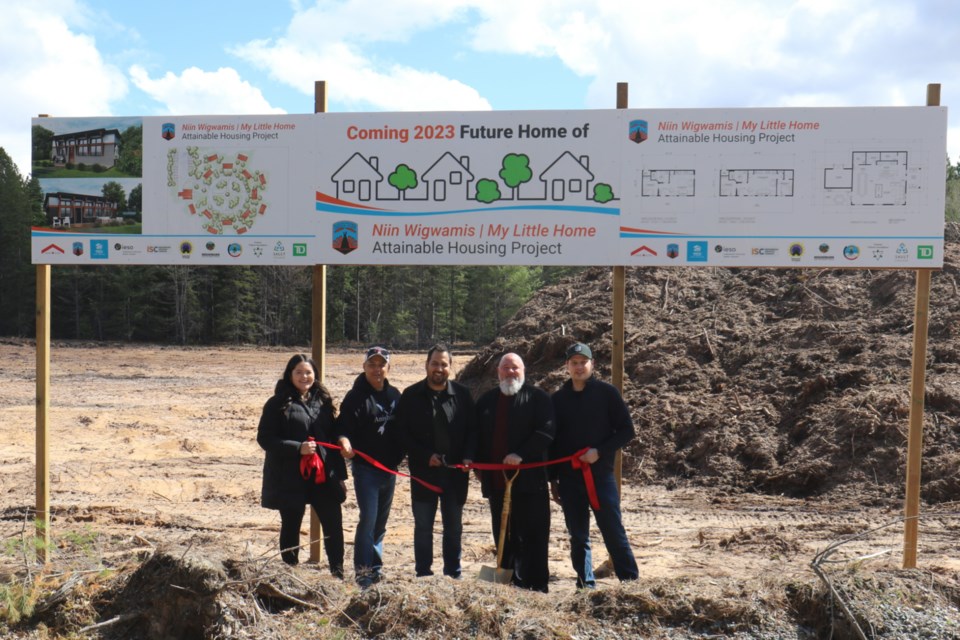Garden River First Nation shares a common challenge faced by many other First Nations across Canada: the waitlist for housing is seemingly miles long, leaving some band members — especially those who are young and single — no other choice than to find accommodations elsewhere.
But leadership in the small community just east of Sault Ste. Marie believes it may have found a solution to potentially address its ongoing housing shortage.
This summer, work is expected to begin on Niin Wigwamis/My Little Home, a project that will see 14 accessible, energy-efficient "tiny homes" constructed on an undeveloped parcel of land in the community in order to provide youth with homes to call their own.
“When we do housing in our community, we find that we’re mainly servicing families, we’re servicing our elders — and there was obviously a gap with our young people,” said Garden River First Nation Chief Andy Rickard, during an interview with SooToday at the Niin Wigwamis/My Little Home site. “We know that access for them is hard to get because priority in our community is usually families.”
A mix of single-bedroom and double-bedroom homes will be built as part of the project, which is anticipated to be completed as early as this fall. Leadership hopes to have community members move into the homes sometime before Christmas.
“I think it’s unique because it’s tiny homes, and I think that’s what makes this thing a little bit different — we’re not building huge duplexes or units like that. This is something that’s attainable,” said Rickard. “It also gives us an idea as leadership; our housing list is so large, and there are a lot of people who are single that require single units.
“For us, here’s another test run to see if that’s an area that we can go to because it doesn’t cost as much. We are running out of land in terms of access to services. Without us getting the money from the government for increased infrastructure, we’ll be waiting for a long time,” he continued. “We’re trying to figure out how we can do out-of-the-box thinking with smaller units, more units on some of the lands that we own here in the community, so that we can address the housing shortage here, but also maximize the space that we do have in the community.”
“It’ll be more of a transitional home, just to help people get on their feet if they want to buy their own home, or they never owned a home before,” added Sydney Nolan, youth housing manager for Garden River First Nation. “Hopefully, it’s kind of like a transition for them.”
The housing project will also provide an opportunity for 10 youth from Garden River to learn how to construct houses by getting hands-on experience through a 10-week building certification program that’s being offered in partnership between the First Nation and Sault College this summer.
“Basically, they’re going to be given the opportunity to learn how to build a home,” said Nolan. “They’ll be actually on site building these homes, learning different skills — and they’ll be certified.”
Niin Wigwamis/My Little Home has a number of stakeholders helping to advance the housing project, including Habitat for Humanity Sault Ste. Marie and Area, Independent Electricity System Operator and Canada Mortgage and Housing Corporation, to name a few. Rickard says all the organizations and agencies involved with the project expressed interest in addressing the gaps in access to housing for young people.
“That’s why it took off, and that’s why we have partners like Ontario Trillium Foundation because they’ve seen that as a unique opportunity,” he said.
Rickard says the Niin Wigwamis/My Little Home project could potentially expand to address other housing gaps in the future, especially for the First Nation’s elderly population.
“We’re looking at options for them, so that it’s easy for them to manage because we understand the limitations of getting older; it’s a little bit challenging to walk up stairs and those kinds of things,” he said. “This is another opportunity for us to say, okay, what are we going to do in terms of providing housing for elders or other families that might require or prefer a smaller house?”
A similar housing project involving tiny homes has been developed in Six Nations territory. Rickard says it’s a source of pride for Garden River First Nation that it’s been introducing innovative developments by looking at what’s been happening in other regions of Ontario and applying those ideas within the community.
“I think that makes a difference, because when I talk about unique or out-of-the-box thinking, they can see the vision of how this is different — it’s not just building a housing unit,” he said. “We’re really focusing on a specific age demographic, but we’re also looking at efficient ways to create a home that’s convenient for those individuals that are looking.”
Financial details, such as the total estimated price tag of the project, are not being disclosed at this time.
— SooToday




